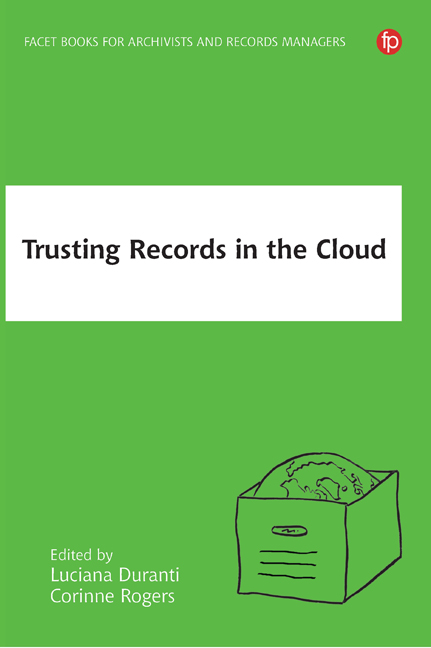Book contents
- Frontmatter
- Contents
- List of Figures and Tables
- Contributors
- 1 Introduction
- 2 The Cloud – Challenges and Issues
- 3 Open Government
- 4 Citizen Engagement
- 5 Strategies, Methods and Tools Enabling Records Governance in a Cloud Environment
- 6 Retention and Disposition
- 7 Authentication
- 8 Intellectual Control
- 9 Exploring Digital Preservation in the Cloud
- 10 Cultural Heritage – Indigenous Perspectives
- 11 The Role of the Records Professional
- 12 Education
- Appendix 1 InterPARES Trust Terminology
- Appendix 2 Products of InterPARES Trust Research
- Index
3 - Open Government
Published online by Cambridge University Press: 24 September 2019
- Frontmatter
- Contents
- List of Figures and Tables
- Contributors
- 1 Introduction
- 2 The Cloud – Challenges and Issues
- 3 Open Government
- 4 Citizen Engagement
- 5 Strategies, Methods and Tools Enabling Records Governance in a Cloud Environment
- 6 Retention and Disposition
- 7 Authentication
- 8 Intellectual Control
- 9 Exploring Digital Preservation in the Cloud
- 10 Cultural Heritage – Indigenous Perspectives
- 11 The Role of the Records Professional
- 12 Education
- Appendix 1 InterPARES Trust Terminology
- Appendix 2 Products of InterPARES Trust Research
- Index
Summary
Introduction
This chapter seeks to investigate and establish the nature of open government and the role of data, records and archives in promoting and enabling open government around the world. It identifies key issues around open government from the literature reviews and from the research-in-practice undertaken as part of the InterPARES Trust (hereinafter ITrust) project. In its conclusion it draws out some lessons for citizens, public organizations, records professionals and records educators working in the arena of open government to demonstrate the vital role that data and records play in enabling open government activities.
Definitions
This section sets out definitions of the main concepts and terms that will be referred to in the chapter.
The ITrust Terminology Database defines open government as:
… an approach designed to provide greater access to unrestricted information held by public bodies in order to promote transparency, accountability, and citizen engagement and participation, to accomplish a larger outcome of building and enhancing citizens’ trust in their governments.
(Pearce-Moses, 2018, s.v. open government)Terms used in this definition are also themselves defined in the ITrust Terminology Database. Accountability is defined as ‘the obligation to answer for actions for which one is responsible’.
Transparency is defined as ‘(the condition of) timely disclosure of information about an individual's or organization's activities and decisions, especially to support accountability to all stakeholders’.
Citizen engagement is defined as:
Efforts to actively empower citizens in government decision-making processes through transparent dialog and communication among individual citizens and with the government in order to increase trust in the government and to ensure decisions reflect citizens’ interests.
(Pearce-Moses, 2018, s.v. citizen engagement)Citizen engagement initiatives may make use of technologies to connect with citizens. Synonyms include citizen participation, civic participation, civic engagement and open dialogue. These issues are treated in detail in Chapter 4 and are not discussed here.
In order to deliver open government, public authorities need to proactively release data and information. Two related definitions are, therefore, open data, defined as ‘data available to anyone that may be used for any purpose and that is in a structure that facilitates its use at little or no charge’ (ITrust Terminology) and open information, that is, ‘the release of government records and published materials for public use, typically in unstructured formats’ (Leveille and Timms, 2015).
- Type
- Chapter
- Information
- Trusting Records and Data in the Cloud , pp. 37 - 64Publisher: FacetPrint publication year: 2018

